|
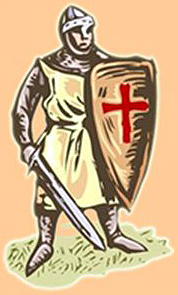
War of 1812: Glossary A-Z
::
Canada
Canada, as mentioned in the context of the War
of 1812, refers to the British dominions in
North America at the time.
In 1867,
Canada (Nova Scotia, New Brunswick, and Canada)
became a united dominion by means of the
British North America
Act, also called the
Constitution Act, of
1867.
See this handy
map:

Canada and
Newfoundland 1623-1905
::
Hartford
Convention
The Hartford Convention was an assembly of
 Federalists
who met from December 15, 1814, to
January 5, 1815, at Hartford, Connecticut, to discuss pressing issues such
as defense and its funding. Federalists
who met from December 15, 1814, to
January 5, 1815, at Hartford, Connecticut, to discuss pressing issues such
as defense and its funding.
The fact that its proceedings took place in
closed sessions, and its unfortunate timing (the
Treaty of Ghent was signed on December 24, 1814)
earned the Federalist Party the reputation of
being unpatriotic, and largely contributed to
its downfall.
Also in the
attendance of this convention were some hardliners
who talked about a
possible secession of New England from the
Union, which, to the rest of the Nation, just
seemed to confirm the aforementioned reputation.
::
Impressment
Impressment is the act or practice of forcibly
enlisting, or to "press," someone into public
service.
The British Royal
Navy, at the time at war with France, suffered a
severe shortage of seamen who cheerfully
switched to become crew members on American
merchant ships because pay and conditions were
much better there.
To reclaim their
British deserters, the Royal Navy simply boarded
American vessels, and seized these men by
authority.
In the process,
many Americans were taken as well.
These American
citizens could hope to be eventually released by
the British government, but it could take years
to verify their citizenship. In the meantime,
they had to work, and fight, for the British.
In 1812 it
was estimated that over 6000 Americans were
serving in British ships, of whom 2500 were
imprisoned for refusing to take up arms against
their own country.
War and Peace
in an Age of Upheaval,
The New Cambridge Modern History
Impressment was
mentioned in the American declaration of war.
However, the United States didn't insist on
addressing the issue in the Treaty of
Ghent, because by then Napoleon had been taken
care of, and British impressment had ceased to
be a concern.
Here is more about
 impressment.
impressment.
:: Political Parties
In the U.S. of 1812, the two major political
parties were the Democratic-Republican Party and
the Federalist Party.
Democratic-Republican Party
Presidents Jefferson, Madison, and Monroe
(combined in office from 1801-1825) were members
of the Democratic-Republican Party.
The
Democratic-Republican Party started out in 1792
as the Republican Party. Opponents called them
Democratic-Republicans, and in 1798, this became
their accepted name.
In 1844, the
Democratic-Republican Party became the
Democratic Party as we know it today.
Federalist Party
The Federalist Party was created in 1791. This
party had the upper hand in American politics
until the end of
 John Adams' presidency in 1801.
John Adams' presidency in 1801.
The War of 1812
broke its back. How so?
In 1812, the House
voted 79 to 49, and the Senate voted 19 to 13 in
favor of the war bill.
Split by political
party, in both houses of Congress, the
Republicans voted 98 to 23 for the war, while
all Federalists voted against the war with 39 to
0.
While the War of
1812 lingered on, Federalists enjoyed popularity
in their opposition. But once the war was over,
a combination of smart moves by the Republican
Party and a general wave of patriotism erased
all credit points so far accumulated by the
Federalists.
The final nail
into the Federalists' coffin was the
 Hartford Convention.
Hartford Convention.
However, it seems
that neither the Hartford Convention nor the
Federalists themselves justifiably deserved the
bad rep that they received.
Their criticism of
the war was legit, the Hartford Convention was,
although ill-timed, a moderate attempt to solve
real problems, and, in the end, the Republican
Party adapted many of the Federalists' views and
goals.
Republican Party
(Grand Old Party)
The Republican Party, as we know it today, was
established in 1856.
Let this map help you:

U.S. Presidential
Elections
and Political Parties 1796
- 1968
::
Re-Export Trade
The re-export trade of American merchants became
a big bone of contention between the United
States and Britain, as well as a
major cause of the War of 1812.
How so?
The
British Rule of 1756
decreed that business with certain colonies
which had been prohibited in times of peace was not
allowed in times of war.
So far, so good.
In the early
1800s, American merchants saw an opportunity to
make a good buck. Because of the tensions between
France and Britain, the French weren't able to
move as freely with their commercial vessels as
they would have liked to.
American ships
sailed to the French West Indian colonies, took
cargo, and, bearing in mind the Rule of 1756,
made a pit stop at an American port, and then
went on to Europe.
Naturally, this re-export didn't sit right with
the British.
Surprisingly,
however, in 1802, a British Admiralty Court
ruled in favor of the Americans. This was the
case of the Polly. The Polly took
cargo from the Spanish West Indies, interrupted
its voyage at Marblehead, Massachusetts, where
it unloaded the cargo, paid customs, reloaded
the cargo, and was then seized en route to Spain
by the British navy.
In May 1805, the
British High Court of Admiralty issued the
Essex Decision,
unmasking a simple stopover in the United States
as such.
The Essex,
by the way, was a U.S. merchant ship seized en
route from Salem to Havana by the British in
1804. The voyage had begun in Barcelona. The
Essex Decision declared this capture legal, thus
restricting neutral shipping.
James Madison
called the Essex Decision a "new and shameful
depredation."
Encouraged by the
Essex Decision, the British Navy seized between
300 an 400 American ships that were engaged in
the reexport trade.
In December 1806,
Britain and the U.S. signed the
 Monroe-Pinkney Treaty,
a treaty of compromise regarding the re-export
trade. But this treaty was never ratified.
Monroe-Pinkney Treaty,
a treaty of compromise regarding the re-export
trade. But this treaty was never ratified.
Instead, the
relationship between the two countries worsened.
Each country responded to the apparent injustice
of the other with a counter law. See also
 The
War of 1812 Builds. The
War of 1812 Builds.
::
Old Northwest
The
Old Northwest, or just Northwest,
refers to the land north of the Ohio River, east
of the Mississippi River, and south of the Great
Lakes.
Today, it is the
states Ohio, Indiana, Illinois, Michigan,
Wisconsin, and a smidgen of Minnesota. Here is
the map:
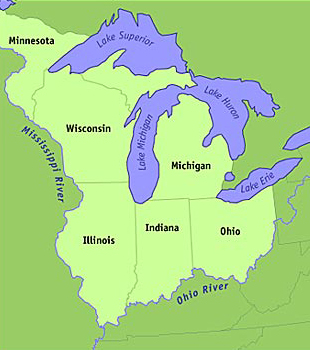
In 1787, the
Old Northwest became
the Northwest Territory.
Ohio achieved
statehood in 1803, Indiana in 1816, Illinois in
1818, Michigan in 1837, Wisconsin in 1848, and
Minnesota 1858.
Back to the Old Northwest.
After the
 1783 Treaty of Paris, at the end of the
1783 Treaty of Paris, at the end of the
 American
Revolution, the Old Northwest switched owners
from the British to the Americans, who were
celebrating their independence.
American
Revolution, the Old Northwest switched owners
from the British to the Americans, who were
celebrating their independence.
Completely ignored
by this treaty, however, was the fact that this
was not vacant territory, nor did the actual
owners have a For Sale sign in their yard.
Therefore, it
became the main objective to find means and justifications
to have the Native Americans surrender or simply
abandon their homes. Whatever made them go
away.
Welcome to the
American Indian Policy 1783-1812.
|
|
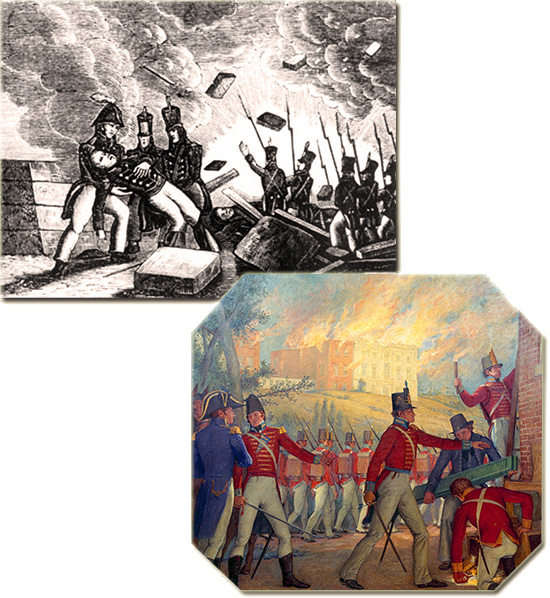
Tit for Tat — The Americans Burn
York (Toronto), the British Burn
Washington D.C.
How Did It Get This Ugly?
The
War of 1812
The War of 1812 is also called the
Anglo-American War, or
America's
Second War of Independence,
because it was the second and last
time the United States went to war
with Great
Britain.
|
|
Some opponents of U.S. President
 James
Madison
(fourth U.S. president, 1809-1817)
referred to it as
Mr.
Madison's War. James
Madison
(fourth U.S. president, 1809-1817)
referred to it as
Mr.
Madison's War.
The War of 1812 was the last war in
American history in which Indian tribes were powerful enough to
defend their collective interests, and therefore influential enough to
play a role in international politics.
Who Fought the War of 1812?
The United States fought against Great Britain.
Indian tribes fought on both sides.
Two Indian wars,
 Tecumseh's Revolt and
the
Tecumseh's Revolt and
the
 Creek
War, are intertwined with the War of 1812. Creek
War, are intertwined with the War of 1812.
Images Above
Picture upper left:
Death of Pike,
1813.
Engraving from Charles J. Peterson's The Military Heroes of the
War of 1812 and the War with Mexico, 1848.
"American General Zebulon Pike commanded the first attack on York on
27 April 1813. He was killed by falling debris when the Grand
Magazine was blown up by the British defenders of Fort York as the
Americans attacked."
Library & Archives Canada
Picture lower right:
The British Burn the Capitol, 1814.
Oil on Canvas by Allyn Cox in 1973-1974
Photograph taken on October 12, 2011, in the Cox Corridors, Capitol.
United States Government Work
Architect of the Capitol |
Who Won
the War of 1812? Who Lost?
The War of 1812 ended in a draw. Nobody won,
least of all the
Native American tribes.
Canada almost certainly gained the most from
this war. This was the second and last time that the U.S. tried to
conquer Canada. In his book The War of 1812, Donald R. Hickey
called it "the closest thing that Canada has had to a war of
independence or a civil war."
The Canadian Government describes the
War of 1812 as "a defining moment in our country's history, paving
the way for Confederation."
When Did the War of
1812 Begin? When Did It End?
The War of 1812 was fought from 1812 to 1815.
The War begun on June 18, 1812, when U.S. President James Madison signed the declaration of war
against Great Britain.
 Check this event in the Timeline of the War of
1812
Check this event in the Timeline of the War of
1812
At the beginning of the War of 1812, the map of
the United States looked like this:
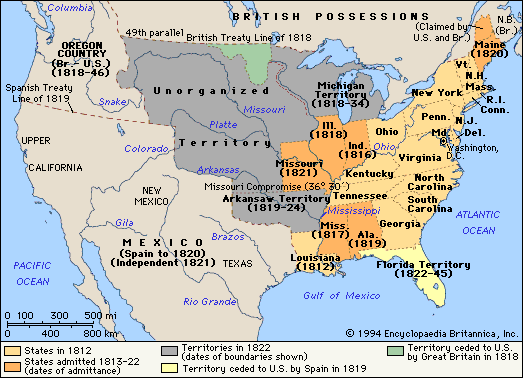
In
Light Orange: The United States in 1812
Encyclopædia Britannica Online
Click map to view more U.S. expansion maps.
The War of 1812 ended on February 17,
1815.
The
 Treaty of
Ghent concluded the war. It was signed on December 24, 1814. But news of the
peace agreement traveled slow, and the British attacked New Orleans on
January 8, 1815. Treaty of
Ghent concluded the war. It was signed on December 24, 1814. But news of the
peace agreement traveled slow, and the British attacked New Orleans on
January 8, 1815.
On February 17, 1815,
ratifications of the Treaty of Ghent were exchanged and President Madison declared
the war at an end.
 Check this event in
the Timeline of the War of 1812
Check this event in
the Timeline of the War of 1812
Where Was the War of 1812 Fought?
The War of 1812 was fought in several
locations:
in Eastern North America (the
 Old
Northwest) / Upper Canada,
Old
Northwest) / Upper Canada,
in
the U.S. Southwest / Mexican Gulf Coast,
in
Chesapeake Bay and up along the Atlantic Coast,
and in the North Atlantic Ocean.
One naval battle was fought off the
coast of Brazil (South Atlantic Ocean), and another one off the
coast of Chile (Pacific Ocean).
And here are the maps:
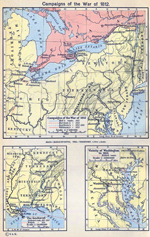
Three Maps of the Campaigns of the War of 1812
Illustrating:
- Hull's route 1812
- Harrison's route 1813
- Dearborn's route 1812-1813
- Wilkinson's route 1813
- Jackson's route 1813-1814
- British route
Click map to enlarge
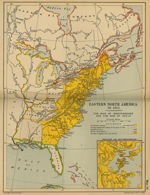
Eastern North America in 1812
Click map to enlarge
The Creek War
The Creek War was fought from July 27,
1813, to March 27, 1814.
Originally not part of the War of
1812, the Creek War was a civil war
between Native Americans and white Americans.
Later, some of the Creek
Indians allied with the British in the War of 1812, while some
others fought against them.
 Davy Crockett
was one of the men who
fought against the Creek in the South under
Davy Crockett
was one of the men who
fought against the Creek in the South under
 General Andrew
Jackson.
General Andrew
Jackson.
Go here for more on the
 Creek War.
Creek War.
Why Was the War of 1812 Fought?
Historians can't agree on
one main cause
of the War of 1812. The key dynamics were
the following:
::
Maritime Rights and Law
Disagreement over maritime rights
between the United States and Great Britain,
namely the
 re-export trade
and the practice of
re-export trade
and the practice of
 impressment
by the British Royal Navy.
impressment
by the British Royal Navy.
:: Expansionism /
Native American Interests
As a result of
ruthless land grabbing by white Americans,
Native Americans rallied around the Shawnee
chief
 Tecumseh
to fight back. Although the British did not
initiate this uprising, they welcomed it.
Tecumseh
to fight back. Although the British did not
initiate this uprising, they welcomed it.
:: The War Hawks
A group of U.S.
congressmen, aka the
War Hawks, argued that American
commerce and American honor was under attack by
the British. Their recommended solution was to
invade
 Canada in order to restore both.
Canada in order to restore both.
Background of the War of 1812: Recent or Ongoing
Wars
:: United
States
The Americans were involved in the
 Quasi-War against France from
July 7, 1798, until September 30, 1800, and the
Tripolitan War against Tripoli
(then part of the Ottoman Empire, today's Libya) from May 14, 1801
until June 4, 1805. The Patriot War
(also called Patriot's War) of
1812 was an unsuccessful attempt to annex Spanish East Florida.
Quasi-War against France from
July 7, 1798, until September 30, 1800, and the
Tripolitan War against Tripoli
(then part of the Ottoman Empire, today's Libya) from May 14, 1801
until June 4, 1805. The Patriot War
(also called Patriot's War) of
1812 was an unsuccessful attempt to annex Spanish East Florida.
:: Britain
On May 16, 1803, Britain declared war on France and the
 Napoleonic Wars begun. The
Napoleonic Wars ended on November 20, 1815.
Napoleonic Wars begun. The
Napoleonic Wars ended on November 20, 1815.
The War of 1812
Builds: A Brief Timeline
Included
are some events that might be helpful to put the
War of 1812 into its historical context.
1783
 Treaty of Paris. Great Britain
recognizes the independent United States.
Treaty of Paris. Great Britain
recognizes the independent United States.
1794
 Jay Treaty. With the Jay
Treaty, Great Britain and
the U.S. try to achieve what the Treaty of Paris should have
accomplished. Maritime claims from both sides are addressed and
successfully handled. U.S.-U.K. relations calm down.
Jay Treaty. With the Jay
Treaty, Great Britain and
the U.S. try to achieve what the Treaty of Paris should have
accomplished. Maritime claims from both sides are addressed and
successfully handled. U.S.-U.K. relations calm down.
 Impressment, however, is an
important issue that was not addressed by the Jay treaty.
Impressment, however, is an
important issue that was not addressed by the Jay treaty.
April 30, 1798
U.S. Congress establishes the
Department of the Navy (naval matters were formerly taken care of by
the War Department.) By 1812, the U.S. Navy will be 4,000 voluntary
recruits and 500 officers strong.
1800
The national capital of the United States is moved from Philadelphia
to Washington D.C., thanks to the Residence
Act of July 16, 1790.
March 4, 1801
 Thomas Jefferson's
inauguration. He will be U.S. President until 1809.
Thomas Jefferson's
inauguration. He will be U.S. President until 1809.
April 30, 1803
 Louisiana Purchase
Louisiana Purchase
May 1805
Essex Decision - A British
maritime law against
 re-export.
re-export.
November 21, 1806
Berlin Decree - Napoleon's
economic warfare against Britain. With his Berlin Decree, Napoleon
declares a blockade of the British Isles. He prohibits all trade
with British ports, including her colonies.
December 31, 1806
Monroe-Pinkney Treaty - U.S. minister James Monroe
and U.S. special envoy William Pinkney are able to negotiate a
treaty with the British, a treaty that addressed all major disagreements with
regards to maritime law, except impressment. Signed on this day by
all parties, this treaty won't make a difference. Why on earth not?
U.S. President Jefferson will decide not to forward it
to the Senate because the issue of impressment was left out.
January 7, 1807
Order in Council - British
answer to Napoleon's Berlin Decree. Britain prohibits
trade with all French ports, including her colonies.
May 1, 1807
Slave Trade Outlawed - Britain
declares the slave trade illegal.
Summer of 1807
Napoleon begins to seize American ships, while referring to his Berlin
Decree.
June 22, 1807
The
 Chesapeake-Leopard Affair is an
incident between the American frigate USS Chesapeake and the British HMS Leopard. Nine miles off
Hampton Roads, Virginia, the British demand
to search the American ship for British deserters, but their request
is denied. British Captain Salusbury Humphreys
then orders to open fire. Immediately, the Chesapeake strikes
its colors. Humphrey takes four alleged deserters with
him and sails into the sunset, leaving behind 3 Americans dead, 18
wounded, one of them mortally, and enough American outrage to last
longer than the War of 1812 itself.
Chesapeake-Leopard Affair is an
incident between the American frigate USS Chesapeake and the British HMS Leopard. Nine miles off
Hampton Roads, Virginia, the British demand
to search the American ship for British deserters, but their request
is denied. British Captain Salusbury Humphreys
then orders to open fire. Immediately, the Chesapeake strikes
its colors. Humphrey takes four alleged deserters with
him and sails into the sunset, leaving behind 3 Americans dead, 18
wounded, one of them mortally, and enough American outrage to last
longer than the War of 1812 itself.
November 11, 1807
Order in Council - The British
further elaborate on their response to Napoleon's Berlin Decree.
From now on, all
neutral ships have to call at British ports or be subjected to a
search by British authorities.
December 17, 1807
Milan Decree - Napoleon's answer
to the British Orders in Council. The French will treat a ship with British papers, or a ship that has
previously called at a British port, as
British, no matter its actual flag, and therefore, is will be seized by France.
December 22, 1807
Embargo Act - The U.S. reacts to
British impressment and the laws issued by Britain and France, which
are severely crippling neutral commerce. In fact, it has become
impossible to remain neutral. This U.S. Embargo Act
prohibits American trade with any other nation. It is a desperate shot in the
own foot and will be repealed on March 1, 1809.
January 1, 1808
Slave Trade Outlawed - The U.S.
declares the slave trade illegal.
March 1, 1809
Non-Intercourse Act - The
American Non-Intercourse Act replaces the Embargo Act from December 22, 1807.
It is allowed to export goods again, but trade with Britain and
France and their respective colonies is still prohibited. However,
the Non-Intercourse Act allows the president to repeal these trade
restrictions in favor of whoever, Britain or France, would revoke
their trade restrictions against the U.S. first. Here is an excerpt:
Be it
enacted that the President of the United
States be, and he hereby is authorized, in
case either France or Great Britain shall so
revoke or modify her edicts, as that they
shall cease to violate the neutral commerce
of the United States, to declare the same by
proclamation: after which the trade of the
United States, suspended by this act, and by
the [Embargo Act] and the several acts
supplementary thereto, may be renewed with
the nation so doing.
March 4, 1809
Madison's Inauguration - Thomas
Jefferson leaves office and
 James Madison becomes the
fourth president of the United States. He will remain in office
until 1817.
James Madison becomes the
fourth president of the United States. He will remain in office
until 1817.
April 19, 1809
Erskine Agreement - The British
secretary of state for foreign affairs, George Canning, instructed
the British minister to Washington, David Montagu Erskine, to
negotiate with the U.S. government a treaty with the aim to reestablish trade between the
two countries. Erskine did just that. President Madison is pleased
with the agreement and announces on April 19, 1809, that trade with Great Britain
will be restored
effective June 10, 1809. Canning will receive Erskine's update on May 22,
1809, and will immediately declare the treaty nil and void because it
failed to mention that the U.S. was willing to let the Royal Navy
seize American ships that were caught trading with France. Erskine
will lose his job and will be replaced by a lesser light, Francis James Jackson.
March 23, 1810
Rambouillet Decree - For
Napoleon, Great Britain and the U.S. are getting way too comfortable with
each other. Thus, he issues his Rambouillet Decree, which orders
to seize all American ships that are in French ports.
May 1, 1810
Macon's Bill No. 2 - The U.S.
Non-Intercourse Act of March 1, 1809, is replaced by the Macon's Bill No. 2. American
trade is now legal with both, Britain and France, until either one
of them will repeal their trade restrictions with the U.S. Other than
that, British and French ships are prohibited from entering U.S.
waters.
August 5, 1810
Cadore Letter - From Napoleon's
drawer of diplomatic con moves, the Cadore Letter was written by
the French foreign secretary, Duc de Cadore, and sent to the U.S.
minister to France, John Armstrong. Cadore promises in vague terms that the
French Berlin and Milan Decrees would cease to be enforced after
November 1810. Judging by the Trianon Decree, which is issued
on this same day, the Cadore Letter is a move to deceive the U.S. government
and to turn the U.S. against Britain. And the Americans will fall
for it.
Also August 5, 1810
Trianon Decree - Napoleon's
secret order to his French subjects to condemn all American vessels
(acquired legally or illegally) that are already in French custody.
September 26, 1810
White settlers in
 Spanish West Florida rise up and declare that the
territory between Mississippi and Pearl River shall henceforth be
known as the independent Republic of West Florida.
This is the
Spanish West Florida rise up and declare that the
territory between Mississippi and Pearl River shall henceforth be
known as the independent Republic of West Florida.
This is the
 West Florida Revolt.
West Florida Revolt.
November 2, 1810
Madison hoodwinked by Napoleon -
In spite of intelligence suggesting otherwise, U.S. President
Madison takes the Cadore Letter as a sincere French commitment and
announces that trade with Britain will be prohibited effective February
2, 1811.
May 16, 1811
USS President v. HMS Little Belt
- The President is sailing off Cape Henry (Virginia Beach) on patrol to
discourage British
 impressment. After chasing the British Little
Belt for more than seven hours, they finally catch up and,
after an unsuccessful attempt to communicate, the Little Belt
opens fire, which the President returns. Even though 32 crew members on the Little Belt
are killed or wounded, the ship refuses assistance.
impressment. After chasing the British Little
Belt for more than seven hours, they finally catch up and,
after an unsuccessful attempt to communicate, the Little Belt
opens fire, which the President returns. Even though 32 crew members on the Little Belt
are killed or wounded, the ship refuses assistance.
July 24, 1811
U.S. Congress called into session
- To assemble on November 4, 1811.
November 4, 1811
First session of the 12th U.S. Congress
November 7, 1811
Battle of Tippecanoe - Approx.
1,000 U.S. troops, led by the governor of Indiana Territory,
William Henry Harrison, are surprised at their
early morning campfire by approx. 500 Native Americans who are able
to launch an initially
successful attack. But Harrison and his men eventually get the upper hand.
The natives have to flee not only the camp but also their nearby
village, Prophetstown or Prophet's Town (near today's Lafayette, Indiana,
named after Tecumseh's brother, aka the Prophet) which
is
subsequently burned by the Americans.
And here is
Prophet's Town on a map:
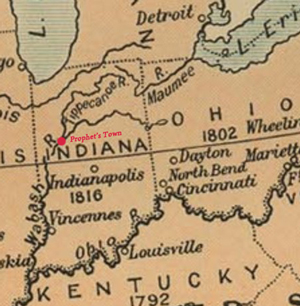
American casualties are approx. 200
dead and wounded. Indian casualties are approx. 100 dead and
wounded. Although Harrison can claim a narrow victory today, this battle
will strengthen the Tribes even more in their resolve to fight side
by side against the Americans in the future.
This battle marks the beginning of
yet another Indian War, also called
Tecumseh's
Revolt, which will merge with the War of 1812.
 Tecumseh himself did not fight in this
battle. He was away on recruiting mission, which was one of the
reasons why Harrison chose his timing the way he did. In fact, hadn't the
Indians attacked first, Harrison would have approached Prophetstown shortly
and a hostile exchange would have been very probable.
Tecumseh himself did not fight in this
battle. He was away on recruiting mission, which was one of the
reasons why Harrison chose his timing the way he did. In fact, hadn't the
Indians attacked first, Harrison would have approached Prophetstown shortly
and a hostile exchange would have been very probable.
By the way, thanks to this battle, Harrison earned his
nickname Old Tippecanoe. In 1841, Harrison became the ninth
president of the United States. He was in office for 32 days,
courtesy of pneumonia.
For subsequent events see the
 Timeline of the War of 1812: Year 1812
Timeline of the War of 1812: Year 1812
What Were the Casualties of the War of 1812?
Here are the U.S. casualties as reported by the
Commissioner of Pensions in the annual report for the fiscal year
1903. These numbers are an excerpt from the
 CRS Report for Congress on American War and Military Operations Casualties:
CRS Report for Congress on American War and Military Operations Casualties:

The following numbers are from Spencer C. Tucker's The
Encyclopedia Of the War Of 1812:
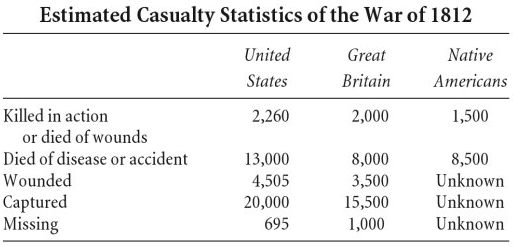
Tucker
further notes that,
the
total number of those killed or wounded on
both sides of the War of 1812 is not known
with certainty.
However, it may have approached 105,000, a
figure that includes estimates of casualties
of American soldiers and civilians, British
and Canadian combatants and civilians, those
Indian tribes fighting for one or the other
side, and the 1813-1814 Creek War, which was
a subset of the larger conflict.
With regards to the war at sea, "American
warships took 165 prizes, and American
privateers made 1344 captures" compared to "200
prizes being brought in by privateers ... 490 by
cruisers" at Nova Scotia, according to War
and Peace in an Age of Upheaval, Cambridge.
Campaigns, Developments,
Battles, and
Key Events
of the War of 1812
|
1812 |
The U.S. opened the
war by an attempt to take possession
of nearby British territory, they
invaded Canada. In the U.S., this
move was highly controversial as it
didn't seem to have much to do with
protecting maritime rights, which
was the main
grievance against the UK and the
main reason for having
declared war.
The first invasion
attempt not only failed, but
backfired. The U.S. lost Detroit. A second invasion attempt
in October 1812, and a third in
November 1812 were equally
ineffective.
However, the U.S. managed to win
some notable battles at sea, which
surprised the British who considered
themselves far superior in that
discipline.
( Quincy
must have been pleased.)
Quincy
must have been pleased.) |
| |
|
|
| |
June 18, 1812 |
The U.S. declares war against Great
Britain. |
| |
June
22, 1812 |
Baltimore
Riots begin and will last
until August. |
| |
July 12, 1812 |
First
U.S. invasion of Canada |
| |
July 17,
1812 |
U.S.
surrender of Fort Mackinac
(Michilimackinac) |
| |
August 5, 1812 |
Battle of Brownstown.
British victory. |
| |
August 9,
1812 |
Battle of
Monguagon (Maguaga). U.S.
victory. |
| |
August
10, 1812 |
Dearborn-Prevost Armistice |
| |
August
15, 1812 |
Fort
Dearborn Massacre |
| |
August 16,
1812 |
U.S.
Surrender of Detroit |
| |
August
19, 1812 |
USS
Constitution vs. HMS
Guerri�re. U.S.
victory. |
| |
October
13, 1812 |
Second
U.S. invasion of Canada.
Battle of Queenston
(Queenstown) Heights. British victory. |
| |
October 18, 1812 |
USS Wasp
vs. HMS Frolic.
U.S. victory. |
| |
October
25, 1812 |
USS United States vs.
HMS Macedonian. U.S.
victory. |
| |
November 20, 1812 |
Third
U.S. invasion of Canada.
First
Battle of Lacolle (La Colle) Mill.
Draw. |
| |
December 29, 1812 |
USS
Constitution vs. HMS Java.
U.S. victory. |
| |
|
|
| |
|
|
|
1813 |
In the
spring of 1813 the Americans captured Fort George, which led to
U.S. control of that
entire frontier. Still, they were unable to
gain actual territory from the
British. Each time
they probed forward they were
beaten.
Good news for the
Americans from the west. By
defeating the British at the Battle
of Lake Erie in September 1813,
Detroit could be recaptured. The
British were pursued into Canada and
again beaten at the Battle of the
Thames, in which Tecumseh was
killed. Indian resistance and
British-Indian relations weakened.
In late 1813, an unsuccessful U.S. campaign was
launched to enclose Montreal.
At sea, the British developed a new strategy.
They pinned down
American ships in their ports by
means of a blockade, which freed their
other vessels to raid American towns up
and down the coastline unpunished. |
| |
|
|
| |
January 22, 1813 |
Battle of Frenchtown,
also called
Battle of the River Raisin.
British victory. |
| |
January 23, 1813 |
Frenchtown Massacre |
| |
February 22, 1813 |
British raid on Ogdensburg, New York |
| |
February 24, 1813 |
USS
Hornet vs. HMS Peacock.
U.S. victory. |
| |
April
13, 1813 |
Spanish surrender of Mobile |
| |
April
27, 1813 |
Battle of
York (today's Toronto).
U.S. victory. |
| |
May
1-9, 1813 |
First Siege
of Fort Meigs. Successful
U.S. defense. |
| |
May 3,
1813 |
The
British sack Havre de Grace,
Maryland |
| |
May
27, 1813 |
Battle of
Fort George. U.S.
victory. |
| |
May
29, 1813 |
Battle of
Sacket's (Sackets) Harbor.
British victory. |
| |
June
1, 1813 |
USS Chesapeake vs.
HMS
Shannon. British
victory. |
| |
June
6, 1813 |
Battle of Stoney Creek.
British victory. |
| |
June
22, 1813 |
Battle
of Craney Island, Virginia. American victory. |
| |
June
24, 1813 |
Battle
of Beaver Dams. British victory. |
| |
June
25, 1813 |
Battle
Hampton. British victory. |
| |
July
11, 1813 |
British raid on Black Rock, New York |
| |
July
21, 1813 |
Second
Siege of Fort Meigs.
Successful U.S. defense. |
| |
July
27, 1813 |
Battle of
Burnt Corn. Red Sticks
victory. |
| |
This battle marks the beginning of
the
 Creek War.
Creek War.
|
| |
August
2, 1813 |
Battle of
Fort Stephenson. U.S.
victory. |
| |
August
10, 1813 |
Battle of
St. Michaels (Michael's).
U.S. victory. |
| |
August
14, 1813 |
USS
Argus vs. HMS Pelican.
British victory. |
| |
August
30, 1813 |
Fort Mims Massacre |
| |
September 5, 1813 |
USS Enterprise vs. HMS
Boxer.
U.S. victory. |
| |
September
10, 1813 |
Battle of Lake Erie. U.S.
victory. |
| |
October 5,
1813 |
Battle
of the Thames, also called Battle of Moraviantown.
U.S. victory. |
| |
October 26,
1813 |
Battle of Châteauguay.
British victory. |
| |
November 1-2, 1813 |
Battle of French Creek.
U.S. victory. |
| |
November 3, 1813 |
Battle
of Tallushatchee.
U.S. victory. |
| |
November 9, 1813 |
Battle
of Talladega.
U.S. victory. |
| |
November 11,
1813 |
Battle of Crysler's Farm.
British victory. |
| |
November 18, 1813 |
Hillabee Massacre |
| |
November 29, 1813 |
Battle of Autossee.
U.S. victory. |
| |
December 10, 1813 |
U.S. burning of Newark, Upper Canada |
| |
December 19, 1813 |
British capture of Fort Niagara,
burning of Lewiston |
| |
December 23, 1813 |
Battle of Econochaca.
U.S. victory. |
| |
December 30, 1813 |
British burning of Black Rock and
Buffalo |
| |
|
|
| |
|
|
|
1814 |
Early
in 1814, the U.S. defeated the Red
Stick Creeks, ending the Creek War.
Yet
another U.S. invasion campaign was
launched into Canada. Fort Erie was
taken and the Americans moved into
Upper Canada. The British succeeded
by pushing the Americans back to
Fort Erie and campaigned into New
York and Chesapeake Bay. Washington
D.C. was looted. New Orleans
was earmarked as a target. But
Baltimore, Lake Champlain, and
Plattsburgh was well defended
and the British drew back into
Canada.
The
Hartford Convention mirrored the
American discontent with a war that
didn't really show much for their
invested efforts.
The
British were exhausted from fighting Napoleon and weary of war. With that the U.S.
could agree. The Treaty of Ghent was
signed. It solved none of the issues
that had led to the war in the first
place,
it simply stopped the war. |
| |
|
|
| |
January 22, 1814 |
Battle of
Emuckfau Creek.
Draw. |
| |
January 24, 1814 |
Battle of
Enitochopco.
Draw. |
| |
January 27, 1814 |
Battle of
Calabee Creek.
U.S. victory. |
| |
March
27, 1814 |
Battle of Horseshoe Bend.
U.S. victory. |
| |
This battle marks the end of
the
 Creek War.
Creek War.
|
| |
March
28, 1814 |
USS
Essex vs. HMS Phoebe and
HMS Cherub.
British victory. |
| |
March
30, 1814 |
Second
Battle of Lacolle (La Colle) Mill.
Draw. |
| |
April
29, 1814 |
USS
Peacock vs. HMS Epervier.
U.S. victory. |
| |
May
5-6, 1814 |
Battle of
Oswego. British victory. |
| |
May
15, 1814 |
U.S. burning of Port Dover |
| |
May
30, 1814 |
Battle of
Sandy Creek. U.S.
victory. |
| |
June
28, 1814 |
USS Wasp
vs. HMS Reindeer.
U.S. victory. |
| |
July
3, 1814 |
First Battle of
Fort Erie. U.S. victory. |
| |
July 5, 1814 |
Battle of Chippewa. U.S. victory. |
| |
July
18, 1814 |
U.S. surrender of Prairie du Chien |
| |
July 25, 1814 |
Battle of Lundy's Lane.
Draw. |
| |
August 3, 1814 |
Battle
of Conjocta Creek. U.S.
victory.
British capture of Hampden. |
| |
August 8, 1814 |
Negotiations
at Ghent begin. |
| |
August 9, 1814 |
Treaty of
Fort Jackson |
| |
August 9-12, 1814 |
Battle of
Stonington.
U.S. victory. |
| |
August 13-
September 16, 1814 |
British Siege
of Fort Erie. |
| |
August 15, 1814 |
Second Battle of
Fort Erie. U.S. victory.
But the siege continues. |
| |
August 24, 1814 |
Battle of
Bladensburg. British victory.
The British occupy Washington D.C. |
| |
August 30, 1814 |
Battle of
Caulk's Field. Draw. |
| |
September 1, 1814 |
USS Wasp
vs. HMS Avon. U.S.
victory. |
| |
September 6, 1814 |
Battle of
Beekmantown. British
victory. |
| |
September 11,
1814 |
Battle of Lake Champlain.
U.S. victory.
Battle of Plattsburgh (Plattsburg).
U.S. victory. |
| |
September
12, 1814 |
Battle of North Point.
British victory. |
| |
September
13-14, 1814 |
Battle of Baltimore. Draw.
The
British bombardment of Fort McHenry
inspires
 Francis Scott Key to write the
words to The Star-Spangled Banner. Francis Scott Key to write the
words to The Star-Spangled Banner. |
| |
September
14-15, 1814 |
First Battle of
Fort Bowyer. U.S.
victory. |
| |
September
17, 1814 |
U.S. Sortie
from Fort Erie. U.S.
victory. |
| |
October 19, 1814 |
Battle of
Cook's Mills.
Draw. |
| |
November 7, 1814 |
Spanish surrender of Pensacola
to the U.S. |
| |
December 14,
1814 |
Battle of
Lake Borgne. British
victory. |
| |
December 15,
1814 -
January 5, 1815 |
 Hartford Convention
Hartford Convention |
| |
December 23,
1814 |
Battle at Villeré Plantation.
Draw. |
| |
December 24,
1814 |
The
Treaty of
Ghent is signed at Ghent, Belgium. |
| |
|
|
| |
|
|
|
1815 |
In the
U.S., news of
the victory at New Orleans arrived
together with the news of the
signing of the peace treaty, which,
to American ears, sounded like the
U.S. had won the war.
A
patriotic wave rolled through the
U.S. The American Federalist party,
having aired criticism of the war by
way of the Hartford Convention, was
painted as a traitor and essentially
done for.
News of the peace treaty traveled
extremely slow in some instances.
The last victims of the War of
1812 died in June 1815 in the Sunda
Strait off Indonesia. |
| |
|
|
| |
January 8,
1815 |
 Battle of New Orleans.
U.S. victory.
Battle of New Orleans.
U.S. victory. |
| |
January 13, 1815 |
Battle of
Point Peter. British
victory. |
| |
January 15, 1815 |
USS President
vs. HMS
Endymion, Tenedos, Pomone.
British victory. |
| |
February 8,
1815 |
News
of the peace treaty at Ghent arrives
in North America. |
| |
February 11,
1815 |
Second
Battle of Fort Bowyer.
British victory. |
| |
February 17,
1815 |
Ratifications of the Treaty of Ghent
were exchanged.
|
|
The War of 1812 is
officially over.
|
| |
February 20,
1815 |
USS Constitution vs. HMS
Cyane and Levant.
U.S. victory. |
| |
March 23, 1815 |
USS Hornet vs. HMS
Penguin.
U.S. victory. |
| |
April 15, 1815 |
Dartmoor Prison Massacre |
| |
June 30, 1815 |
USS Peacock vs.
Nautilus.
U.S. victory. |
Detailed Timelines of
the War of 1812
 Timeline of the War of 1812: Year 1812
Timeline of the War of 1812: Year 1812
 Timeline of the War of 1812: Year 1813
Timeline of the War of 1812: Year 1813
 Timeline of the War of 1812: Year 1814
Timeline of the War of 1812: Year 1814
 Timeline of the War of 1812: Year 1815
Timeline of the War of 1812: Year 1815
More Maps
In 1815, at the end of the War of 1812, the world looked like this
on a map with regards to European Colonies and Dependencies:
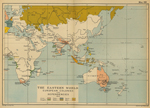
1815
Eastern World
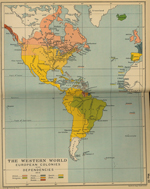
1815
Western World
These two maps illustrate settled areas in the U.S. by 1800 and 1820
respectively:
Here's a huge map of all US Battle Sites
from 1689 - 1945:

United
States 1689 - 1945 Battle Sites
Click Map to enlarge
Black Soldiers in the War of 1812
Go here for
 Emancipation: Black Soldiers in the War of
1812
Emancipation: Black Soldiers in the War of
1812
How Expensive Was the
War of 1812?
Here is the total military cost of the
War of 1812 in comparison with other major wars. The numbers are
from the
 CRS Report for Congress on Costs of Major U.S.
Wars - July 24, 2008.
CRS Report for Congress on Costs of Major U.S.
Wars - July 24, 2008.
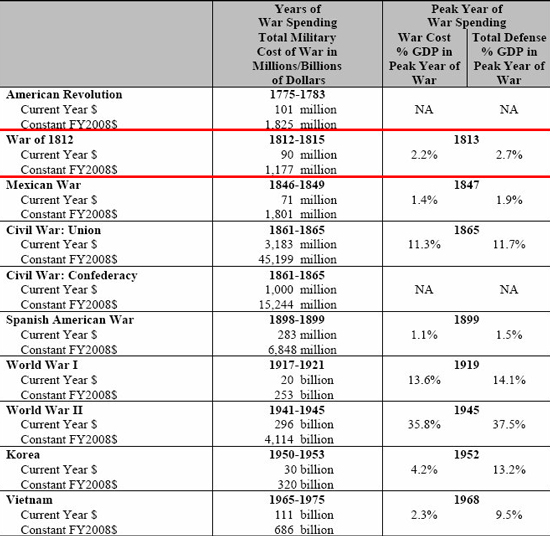
More Timelines
Here are the timelines of the
 Napoleonic Wars for the years
1812-1815:
Napoleonic Wars for the years
1812-1815:
 Napoleonic Wars: Year 1812
Napoleonic Wars: Year 1812
 Napoleonic Wars: Year 1813
Napoleonic Wars: Year 1813
 Napoleonic Wars: Year 1814
Napoleonic Wars: Year 1814
 Napoleonic Wars: Year 1815
Napoleonic Wars: Year 1815
And then maybe the
 American
Timeline
American
Timeline
More History
|